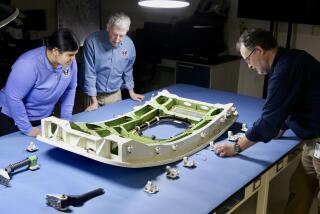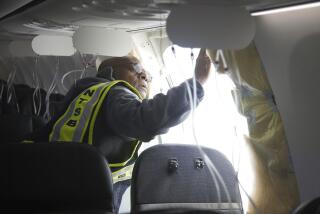Dozens of Screws Left Out of Plane’s Tail Before Crash
- Share via
EAGLE LAKE, Tex. — A commuter airplane that plunged into a cornfield, killing all 14 people aboard, was missing dozens of screws in its tail section after undergoing maintenance the day before the crash, an investigator said Friday.
The screws were supposed to hold in place part of the airplane’s horizontal stabilizer, a wing that keeps an airplane horizontal in flight.
“Obviously, the plane should not have left the hangar without the screws,” Jim Kolstad, chairman of the National Transportation Safety Board, said at an evening news conference.
The twin-turboprop Continental Express airplane went into a hangar in Houston for routine maintenance on Tuesday, the day before the crash, and left without 43 screws in the leading edge of its horizontal stabilizer, Kolstad said.
The stabilizer is a piece that perpendicularly crosses the tail. The leading edge is a slanted area that allows air to flow over the stabilizer and back to movable elevators, slats that cause the airplane’s nose to angle up or down.
A 9-foot-long piece of the stabilizer’s leading edge probably came off the Brazilian-made Embraer-120 in mid-flight, Kolstad said. The loss would have caused the wing to nose down sharply toward the ground.
Art Kent, spokesman for Continental Airlines, said that the investigation was still too premature to determine the exact cause of the crash.
“I would remind you it’s far too early to come to any conclusion,” he said. “We want to know what’s up more than anyone.”
At an earlier news conference Friday, Kolstad said that a cockpit voice recorder picked up loud noises and a “whooshing” sound before the airplane crashed.
“The tape shows normal takeoff, climb and cruise,” Kolstad said. “There was very little crew conversation.
“All of a sudden there was a loud noise, followed a few seconds later by an even louder noise that was followed by a series of warning horns and messages. Then there was a very loud whooshing sound and then the end of the tape,” he said.
The information came from the so-called black boxes recovered from the wreckage.
The twin-engine commuter plane was heading to Houston’s Intercontinental Airport from Laredo on Wednesday morning when, according to eyewitnesses, it dropped speed, caught fire and crashed into a cornfield near Eagle Lake, 75 miles west of Houston.
There were no survivors.
Investigators discovered Thursday that the 11 passengers were not wearing seat belts.
Investigators would not speculate on whether the passengers and three crew members, whose bodies were found in the front or rear of the plane, were trying to flee a fire or another malfunction in the passenger section.
Nothing on the tape indicated the pilot allowed them to unfasten their seat belts, Kolstad said.
It took between eight and 10 seconds for the plane to fall to the ground, he said.
“What was described to me was not the sound of an explosion. I don’t believe it was an explosion,” he said at a crash-site briefing.
He said that the whooshing sounded like air.
“There was no indication by the crew of anything like, ‘Oh my God, we’ve got a fire.’ There was no discussion of the incident as it occurred. There was no indication of anything wrong at any time.”
A second recording box, the flight data recorder, showed normal readings until the plane’s nose dropped. On Thursday, Kolstad said that the plane’s airspeed dropped suddenly from about 300 miles an hour to about 180 miles an hour immediately before the crash.
The flight data recorder shows both engines operated normally until the time the recording ended.
More to Read
Sign up for Essential California
The most important California stories and recommendations in your inbox every morning.
You may occasionally receive promotional content from the Los Angeles Times.













